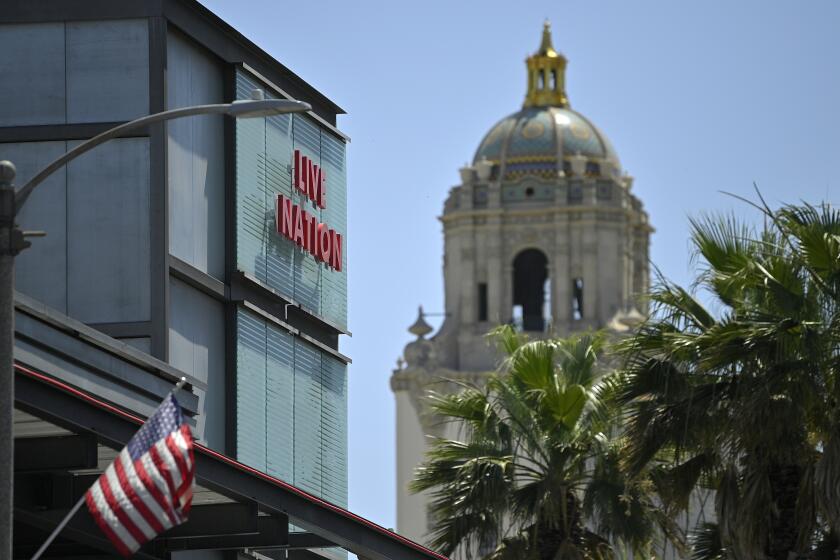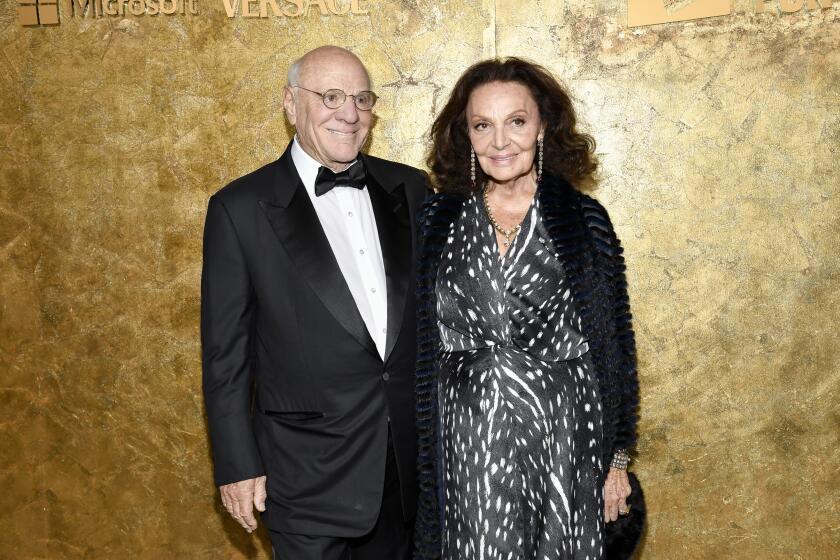Standing Ritual
- Share via
The reviews are in:
“They remembered their lines!”
“The whole cast showed up!”
“Nobody fell into the orchestra pit!”
“People sang stuff and danced!”
In reality, no publication printed these reviews; you’d never find a legitimate theater critic waxing rhapsodic over the basic requirements of putting on a show. The production that they didn’t write about does not exist either.
But, after years of observing the behavior of theatergoers in Greater Los Angeles, one reaches the conclusion that neither the nonexistence of this show--nor its astonishing mediocrity--would stop an L.A. audience from giving it a standing ovation.
It may be more difficult to please the critics--but to make the Los Angeles theater crowd happy, it seems that all you have to do is finish the show. Can’t act, can’t sing, can’t dance--but, hey, nobody’s perfect.
Posing the question “Are there too many standing ovations in Los Angeles?” touches a nerve with some members of the local theater community, who insist this is a misconception fueled by jaded journalists who attend way too many opening nights, where the house is papered with friends, agents, celebrities and the performers’ moms and dads.
“I am totally in favor of standing ovations,” says Rick Barr, general manager of Pasadena Civic Auditorium. “I think the press and others are looking to be cynical about it, to say that audiences don’t know what they’re doing, that it’s too frequent, that it doesn’t mean anything. It means something, it’s the audience’s way of responding.”
But fact or fiction, there exists a widely held perception that audiences here in the show-biz capital will give a standing ovation to anything that moves.
Sheldon Epps, artistic director of the Pasadena Playhouse, wonders if too much standing is confusing for audiences and performers. “If it now occurs for anything and everything that you see, what defines that theater experience as being great instead of moderately successful?” he muses.
Then again, maybe not. “I do feel that, if you go to the theater often, you can feel the difference between one that is genuine, and one that is pro forma, or perfunctory. There is a spontaneity and energy about a real standing ovation instead of one that is about etiquette.”
Well, there’s something new for L.A. actors to worry about: To paraphrase a line from a neurotic character in a classic Woody Allen film, you’ve finally had a standing ovation, but it was the wrong kind.
Some believe the standing ovation--of whatever kind--has become like the 15% tip: no longer a recognition for exceptional service, but an obligatory payment to any waiter who doesn’t drop the catch-of-the-day on your head (those servers get 20%, so they won’t feel bad).
Does our penchant for standing ovations reflect a national trend toward over-congratulation, the theatrical equivalent of grade inflation? Are we seeing in the theater the same trend that has led horrified educational psychologists to speculate we’ve created a generation of egocentric monster children with too much self-esteem?
Or are we simply experiencing something that’s only natural in a town full of actors, directors, writers and stage or film crews? After all, where else in America do you find movie audiences wildly applauding the technical credits, cheering for the gaffer, the key grip or the unit publicist as lustily as for Dustin or Denzel? (For those of you who applaud after movies, there’s something you should take steps to deal with: The people for whom you are clapping are not really there. Same goes for any standing ovations you may be awarding to your TV screen.)
Possible, too, that standing ovations happen more here because whether you’re in the entertainment industry on not, you’re in the industry. This is Hollywood, baby, whether you live in Beverly Hills or just east of the Cerritos Auto Square. Even if you aren’t looking to be discovered, you could be. Everything here is a performance, an audition, and that includes applauding for someone else.
A few years back, in a Melrose hair salon, I overheard a woman instructing her hairdresser that she needed her shortish red-gold locks cut in such a way that her coif would look best just after she ran both hands through her hair.
“I have this gesture that I do a lot,” she explained very seriously, demonstrating the move. Suddenly, it was the end of an exciting, exhaustingly creative business meeting; her fingers swept through the red-gold thatch in the sort of frustrated but exhilarated brain-massage only a woman with such an exciting, exhaustingly creative life would require.
Maybe our standing ovations are like that gesture--pure theater. By the end of the performance, her hair is standing, and so are we.
In another twist on the standing ovation as performance art theory, Gil Cates, producing director at Westwood’s Geffen Playhouse, believes people on the West Coast are just more demonstrative than they are on the East Coast. “I do think that people in L.A., while they are generally more jaded and have been exposed to more special events, are nonetheless still looser than the people in the East,” Cates says.
Elizabeth Kennedy, director of administration for Los Angeles Opera, agrees. “It is a fairly discerning audience, but when they see something they really like, it’s something they make known,” Kennedy says. “They are not worried about whether it’s naive to appear enthusiastic. It may have something to do with tradition--the tradition of going to the performing arts is younger here, so we are not quite as hidebound as to the way we are supposed to behave.”
She adds, however, that while Los Angeles audiences are more likely to share their feelings than, say, Philadelphia’s, it’s nothing compared with the hooting and hollering that goes on in the opera houses of Italy. “They have standing ovations that are half an hour long,” she says. “We don’t have quite as many people booing and hissing, either; the audience is a little more restrained. There are cultural differences.”
Beyond California’s predilection for openness, Cates, like many others, believes the obligatory opening-night ovation is as likely to happen in the Big Apple as the Big Orange, because the show’s investors are sitting front row center. “I’ve never seen anything halfway decent where the audience didn’t stand,” Cates says. “People who put up their money are going to stand unless it’s a real turkey.”
Cates’ turkey theory was proven only hours after this conversation took place. “Oscar and Felix, A New Look at the Odd Couple,” opened at the Geffen the same night. Times reviewer Sean Mitchell, who gave “Oscar and Felix” a lukewarm review, reports that less than half of the audience responded with the standard opening-night ovation.
This, even with what is usually an L.A. standing ovation guarantee: The stars of the show, John Larroquette and Joe Regalbuto, both had sitcoms that were on long enough to be sold into syndication (“Night Court” and “Murphy Brown,” respectively).
The following night fewer than 15 people stood. That is, of those who remained in the theater until the end--apparently many who came to the show expecting escapist entertainment instead found an entertainment best escaped at intermission.
Whether it’s New York, L.A. or somewhere in between, Martin Wiviott, managing director of Broadway/L.A., calls it unfair to hold an audience’s standing ovation to some sort of pious ethical standard. “Whatever the reason is, whether the person is there to support a friend or because they love the music of the show, you are happy to have them there,” he says. “What they do isn’t phony to them. It’s their reaction; it’s not wrong just because it isn’t my reaction.”
According to its artistic director, Ed Waterstreet, if you really want to gauge honest audience reaction to a show, come to Deaf West Theatre in North Hollywood.
Never mind those star-studded opening nights; just listen to the deaf. “Deaf people are a tougher sell,” he says. “A lot of them haven’t gone to theater a lot, so they are learning to be an audience when they come to our shows. Sometimes hearing people will give a standing ovation just because it’s a new thing. But the deaf people, they have to be convinced.”
Deaf audience members often choose to wave their arms in the air instead of applauding, so deaf actors can see their appreciation. Waterstreet notes that the hearing audience often copies the behavior. Personally, Waterstreet prefers to see a combination of both. “I like applauding up in the air,” he says. “Because then you have the sound for the hearing people, and the visual cue.”
Jimmie McDermott, senior stage manager for the Mark Taper Forum and the Ahmanson Theatre, also endorses some audience respect for the magic of theater. Not necessarily a standing ovation--just something a little more courteous than rising in order to be the first one out the door.
“You’ll find it happening at the Taper all the time--the minute the curtain call starts, people are starting to leave, which I find extremely rude,” he says. “These actors have worked all night to either entertain you or not entertain you. The fact is, they have worked, even if it’s a bad show.”
More to Read
The biggest entertainment stories
Get our big stories about Hollywood, film, television, music, arts, culture and more right in your inbox as soon as they publish.
You may occasionally receive promotional content from the Los Angeles Times.










